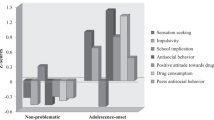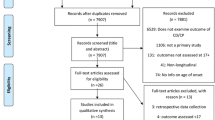Abstract
Youth with conduct problems (CP) may experience high rates of depressive symptoms (DS). However, little is known about the direction of the longitudinal associations between CP and DS in this specific population. Although girls with CP appear at greater risk than boys for presenting comorbid depression, empirical research on gender differences in these associations is even sparser. The current study used autoregressive latent trajectory models to compare four perspectives with hypotheses regarding the longitudinal associations between CP and DS, while taking into account the evolution of both problems. We also examined gender differences in the longitudinal associations. A total of 345 children (40.6 % female) presenting with a high level of CP in early elementary school (mean age at study inception = 8.52; SD = .94) were evaluated annually over a four-year period (5 measurement time points). The results revealed that CP and DS were quite stable over time. Moreover, CP and DS showed strong covariation at each measurement time point, but only one significant positive cross-lagged association between the two processes, indicating that higher levels of DS at time 3 were associated with higher levels of CP 1 year later. No differences were observed in the longitudinal associations between CP and DS in boys and girls. Given the comorbidity and stability of CP and DS, these findings suggest that DS should be systematically evaluated among children with early clinically significant CP, and treatment plans should include interventions aimed at both CP and DS among children who present with both types of problems.



Similar content being viewed by others
Notes
Detailed descriptive results are available upon request from the first author.
Ibid.
The results of the univariate models are available upon request from the first author.
References
Bird HR, Davies M, Duarte CS, Shen S, Loeber R, Canino GJ (2006) A study of disruptive behavior disorders in Puerto Rican youth: II. Baseline prevalence, comorbidity, and correlates in two sites. J Am Acad Child Adolesc Psychiatry 45(9):1042–1053
Maughan B, Rowe R, Messer J, Goodman R, Meltzer H (2004) Conduct disorder and oppositional defiant disorder in a national sample: developmental epidemiology. J Child Psychol Psychiatry 45(3):609–621
Stringaris A, Lewis G, Maughan B (2014) Developmental pathways from childhood conduct problems to early adult depression: findings from the ALSPAC cohort. Br J Psychiatry 205(1):17–23
Costello EJ, Mustillo S, Erkanli A, Keeler G, Angold A (2003) Prevalence and development of psychiatric disorders in childhood and adolescence. Arch Gen Psychiatry 60(8):837–844
Stringaris A, Maughan B, Copeland WS, Costello E, Angold A (2013) Irritable mood as a symptom of depression in youth: prevalence, developmental, and clinical correlates in the Great Smoky Mountains Study. J Am Acad Child Adolesc Psychiatry 52(8):831–840
Capaldi DM, Stoolmiller M (1999) Co-occurrence of conduct problems and adolescent boys: III prediction to young-adult adjustment. Dev Psychopathol 11(1):59–84
Diamantopoulou S, Verhulst FC, van der Ende J (2011) Gender differences in the development and adult outcome of co-occurring depression and delinquency in adolescence. J Abnorm Psychol 120(3):644–655
Chen R, Simons-Morton B (2009) Concurrent changes in conduct problems and depressive symptoms in early adolescents: a developmental person-centered approach. Dev Psychopathol 21(1):285–307
Wolff JC, Ollendick TH (2006) The comorbidity of conduct problems and depression in childhood and adolescence. Clin Child Fam Psychol Rev 9(3–4):201–220
Costello E, He J, Sampson NA, Kessler RC, Merikangas K (2014) Services for adolescents with psychiatric disorders: 12-month data from the National Comorbidity Survey—Adolescent. Psychiatr Serv 65(3):359–366
Lewinsohn PM, Rohde P, Seeley JR (1995) Adolescent psychopathology: III. The clinical consequences of comorbidity. J Am Acad Child Adolesc Psychiatry 34(4):510–519
Capaldi DM (1991) Co-occurrence of conduct problems and depressive symptoms in early adolescent boys: I. Familial factors and general adjustment at grade 6. Dev Psychopathol 3(3):277–300
Capaldi DM (1992) Co-occurrence of conduct problems and depressive symptoms in early adolescent boys: II. A 2-year follow-up at grade 8. Dev Psychopathol 4(1):125–144
Patterson GR, Capaldi DM (1990) A meditational model for boys’ depressed mood. In: Rolf J, Masten AS, Cicchetti D, Neuchterlein KH, Weintraub S (eds) Risk and protective factors in the development of psychopathology. Cambridge University Press, New York, pp 141–163
Gooren EC, van Lier PC, Stegge H, Terwogt M, Koot HM (2011) The development of conduct problems and depressive symptoms in early elementary school children: the role of peer rejection. J Clin Child Adolesc Psychol 40(2):245–253
Van der Giessen DD, Branje SS, Overbeek GG, Frijns TT, van Lier PC, Koot HM, Meeus WW (2013) Co-occurrence of aggressive behavior and depressive symptoms in early adolescence: a longitudinal multi-informant study. Eur Rev Appl Psychol 63(4):193–201
Carlson GA, Cantwell DP (1980) Unmasking masked depression in children and adolescents. Am J Psychiatry 137(4):445–449
Kofler MJ, McCart MR, Zajac K, Ruggiero KJ, Saunders BE, Kilpatrick DG (2011) Depression and delinquency covariation in an accelerated longitudinal sample of adolescents. J Consult Clin Psychol 79(4):458–469
Loukas A, Ripperger-Suhler KG, Horton KD (2009) Examining temporal associations between school connectedness and early adolescent adjustment. J Youth Adolesc 38(6):804–812
Masten AS, Roisman GI, Long JD, Burt KB, Obradović J, Riley JR, Bloelcke-Stennes K, Tellegen A (2005) Developmental cascades: linking academic achievement and externalizing and internalizing symptoms over 20 years. Dev Psychopathol 41(5):733–746
Hipwell A (2011) Impact of oppositional defiant disorder dimensions on the temporal ordering of conduct problems and depression across childhood and adolescence in girls. J Child Psychol Psychiatry 52(10):1099–1108
Fergusson DM, Lynskey MT, Horwood LJ (1996) Origins of comorbidity between conduct and affective disorders. J Am Acad Child Adolesc Psychiatry 35(4):451–460
Ingoldsby E, Kohl G, McMahon R, Lengua L (2006) Conduct problems, depressive symptomatology and their co-occurring presentation in childhood as predictors of adjustment in early adolescence. J Abnorm Child Psychol 34(5):603–621
Overbeek G, Vollebergh W, Meeus W, Engels R, Luijpers E (2001) Course, co-occurrence, and longitudinal associations of emotional disturbance and delinquency from adolescence to young adulthood: a six-year three-wave study. J Youth Adolesc 30(4):401–426
Vieno A, Kiesner J, Pastore M, Santinello M (2008) Antisocial behavior and depressive symptoms: longitudinal and concurrent relations. Adolesc 43(171):649–660
van Lier P, Vitaro F, Barker ED, Brendgen M, Tremblay RE, Boivin M (2012) Peer victimization, poor academic achievement, and the link between childhood externalizing and internalizing problems. Child Dev 83(5):1775–1788
Brensilver M, Negriff S, Mennen FE, Trickett PK (2011) Longitudinal relations between depressive symptoms and externalizing behavior in adolescence: moderating effects of maltreatment experience and gender. J Clin Child Adolesc Psychol 40(4):607–617
Fagan AA, Western JJ (2003) Gender differences in the relationship between offending, self-harm and depression in adolescence and young adulthood. Aust N Z J Criminol 36(3):320–337
Ritakallio MM, Koivisto AM, von der Pahlen BB, Pelkonen MM, Marttunen MM, Kaltiala-Heino RR (2008) Continuity, comorbidity and longitudinal associations between depression and antisocial behaviour in middle adolescence: a 2-year prospective follow-up study. J Adolesc 31(3):355–370
Wiesner M (2003) A longitudinal latent variable analysis of reciprocal relations between depressive symptoms and delinquency during adolescence. J Abnorm Psychol 112(4):633–645
Messer J, Goodman R, Rowe R, Meltzer H, Maughan B (2006) Preadolescent conduct problems in girls and boys. J Am Acad Child Adolesc Psychiatry 45(2):184–191
Bollen KA, Curran PJ (2004) Autoregressive latent trajectory (ALT) models: a synthesis of two traditions. Sociol Methods Res 32(3):336–383
Bollen KA, Curran PJ (2006) Latent curve models: a structural equation perspective. Wiley, Hoboken
Achenbach TM, Rescorla LA (2001) Manual for the Achenbach system of empirically based assessment (ASEBA) school-age forms and profiles. University of Vermont, Research Center for Children, Youth and Families, Burlington
American Psychiatric Association (1994) Diagnostic and statistical manual of mental disorders. DSM-4, 4th edn. American Psychiatric Association, Arlington
American Psychiatric Association (2013) Diagnostic and statistical manual of mental disorders. DSM-5, 5th edn. American Psychiatric Association, Arlington
Rescorla LA, Bochicchio L, Achenbach TM, Ivanova MY, Almqvist F, Begovac I, Verhulst FC (2014) Parent–teacher agreement on children’s problems in 21 societies. J Clin Child Adolesc Psychol 43(4):627–642
Youngstrom EA, Findling RL, Calabrese JR (2003) Who are the comorbid adolescents? Agreement between psychiatric diagnosis, youth, parent, and teacher report. J Abnorm Child Psychol 31(3):231–245
Lengua LJ, Sadowski CA, Friedrich WN, Fisher J (2001) Rationally and empirically derived dimensions of children’s symptomatology: expert ratings and confirmatory factor analyses of the CBCL. J Consult Clin Psychol 69(4):683–698
Statistics Canada (2014) Seuils de faible revenu, MFR-seuils avant impôt, selon la taille du ménage, Québec, 1996–2011 [Low income thresholds, MFR-thresholds befor tax, according to household size]. Enquête sur la dynamique du travail et du revenu (EDTR) [Dynamic Survey on Labour and Income]. Adapted by the Institut de la statistique du Québec, Gouvernement du Québec. http://www.stat.gouv.qc.ca/statistiques/conditions-vie-societe/revenu/faible-revenu/seuilsmfr_qcavi.htm. Accessed Nov 5, 2014
Morin AJS, Maïano C, Marsh HW, Janosz M, Nagengast B (2001) The longitudinal interplay of adolescents’ self-esteem and body image: a conditional autoregressive latent trajectory analysis. Multivar Behav Res 46(2):157–201
Muthén BO, Muthén LK (2014) Mplus 7.2. Muthén et Muthén, Los Angeles
Hu L, Bentler PM (1999) Cutoff criteria for fit indexes in covariance structure analysis: conventional criteria versus new alternatives. Struct Equ Model 6(1):1–55
Kline RB (2011) Principles and practice of structural equation modeling, 3rd edn. Guilford Press, New York
Rawana JS, Morgan AS (2014) Trajectories of depressive symptoms from adolescence to young adulthood: the role of self-esteem and body-related predictors. J Youth Adolesc 43(4):597–611
Keenan K, Hipwell AE (2005) Preadolescent clues to understanding depression in girls. Clin Child Fam Psychol 8(2):89–105. doi:10.1007/s10567-005-4750-3
Costello E, Erkanli A, Angold A (2006) Is there an epidemic of child or adolescent depression? J Child Psychol Psychiatry 47(12):1263–1271
Rohde P, Clarke GN, Mace DE, Jorgensen JS, Seeley JR (2004) An efficacy/effectiveness study of cognitive-behavioral treatment for adolescents with comorbid major depression and conduct disorder. J Am Acad Child Adolesc Psychiatry 43(6):660–668
Author information
Authors and Affiliations
Corresponding author
Ethics declarations
Conflict of interest
The authors declare that they have no conflict of interest.
Rights and permissions
About this article
Cite this article
Poirier, M., Déry, M., Temcheff, C.E. et al. Longitudinal associations between conduct problems and depressive symptoms among girls and boys with early conduct problems. Eur Child Adolesc Psychiatry 25, 743–754 (2016). https://doi.org/10.1007/s00787-015-0796-z
Received:
Accepted:
Published:
Issue Date:
DOI: https://doi.org/10.1007/s00787-015-0796-z




